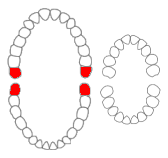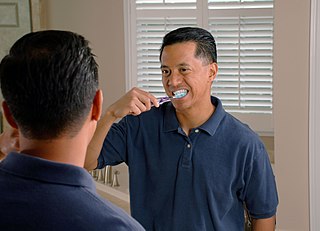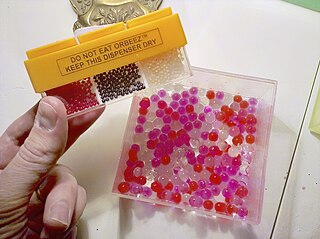
A toothbrush is an oral hygiene tool used to clean the teeth, gums, and tongue. It consists of a head of tightly clustered bristles, atop of which toothpaste can be applied, mounted on a handle which facilitates the cleaning of hard-to-reach areas of the mouth. They should be used in conjunction with something to clean between the teeth where the bristles of the toothbrush cannot reach - for example floss, tape or interdental brushes.

Choking, also known as foreign body airway obstruction (FBAO), is a phenomenon that occurs when breathing is impeded by a blockage inside of the respiratory tract. An obstruction that prevents oxygen from entering the lungs results in oxygen deprivation. Although oxygen stored in the blood and lungs can keep a person alive for several minutes after breathing stops, choking often leads to death.

Chewing gum is a soft, cohesive substance designed to be chewed without being swallowed. Modern chewing gum is composed of gum base, sweeteners, softeners/plasticizers, flavors, colors, and, typically, a hard or powdered polyol coating. Its texture is reminiscent of rubber because of the physical-chemical properties of its polymer, plasticizer, and resin components, which contribute to its elastic-plastic, sticky, chewy characteristics.

The third molar, commonly called wisdom tooth, is the most posterior of the three molars in each quadrant of the human dentition. The age at which wisdom teeth come through (erupt) is variable, but this generally occurs between late teens and early twenties. Most adults have four wisdom teeth, one in each of the four quadrants, but it is possible to have none, fewer, or more, in which case the extras are called supernumerary teeth. Wisdom teeth may become stuck (impacted) against other teeth if there is not enough space for them to come through normally. Impacted wisdom teeth are still sometimes removed for orthodontic treatment, believing that they move the other teeth and cause crowding, though this is not held anymore as true.

Baby food is any soft, easily consumed food other than breastmilk or infant formula that is made specifically for human babies between six months and two years old. The food comes in many varieties and flavors that are purchased ready-made from producers, or it may be table food eaten by the family that has been mashed or otherwise broken down.

A product recall is a request from a manufacturer to return a product after the discovery of safety issues or product defects that might endanger the consumer or put the maker/seller at risk of legal action.

Teething is the process by which an infant's first teeth appear by emerging through the gums, typically arriving in pairs. The mandibular central incisors are the first primary teeth to erupt, usually between 6 and 10 months of age and usually causes discomfort and pain to the infant. It can take several years for all 20 teeth to complete the tooth eruption. Though the process of teething is sometimes referred to as "cutting teeth", when teeth emerge through the gums they do not cut through the flesh. Instead, hormones are released within the body that cause some cells in the gums to die and separate, allowing the teeth to come through.

A pacifier is a rubber, plastic, or silicone nipple substitute given to an infant or toddler to suckle upon between feedings to quiet its distress by satisfying the need to suck when it does not need to eat. Pacifiers normally have three parts: an elongated teat, a handle, and a mouth shield which prevents the child from swallowing or choking on it.

Deciduous teeth or primary teeth, also informally known as baby teeth, milk teeth, or temporary teeth, are the first set of teeth in the growth and development of humans and other diphyodonts, which include most mammals but not elephants, kangaroos, or manatees, which are polyphyodonts. Deciduous teeth develop during the embryonic stage of development and erupt during infancy. They are usually lost and replaced by permanent teeth, but in the absence of their permanent replacements, they can remain functional for many years into adulthood.
Child development stages are the theoretical milestones of child development, some of which are asserted in nativist theories. This article discusses the most widely accepted developmental stages in children. There exists a wide variation in terms of what is considered "normal", caused by variations in genetic, cognitive, physical, family, cultural, nutritional, educational, and environmental factors. Many children reach some or most of these milestones at different times from the norm.

A chew toy is an object designed to be chewed on by animals for stimulation, boredom and relief. Chew toys can help relieve pain associated with teething, this is especially true for younger animals, such as puppies. There are several types of chew toys made from different materials including; rawhide, wood, paper, and mineral. Chew toys are commonly associated with dogs, but have also been effective with birds, rodents, and rabbits. Human infants are given a similar toy called a teether, to help soothe inflamed gums during teething.

Tooth brushing is the act of scrubbing teeth with a toothbrush equipped with toothpaste. Interdental cleaning can be useful with tooth brushing, and together these two activities are the primary means of cleaning teeth, one of the main aspects of oral hygiene. The recommended amount of time for tooth brushing is two minutes.

Toys specifically marketed for dogs to play with come in many varieties, including dog bones, puppy toys, balls, tug toys, training aids, squeaky toys, discs and frisbees, plush toys, and sticks.

Fisher-Price is an American company that produces educational toys for infants, toddlers and preschoolers, headquartered in East Aurora, New York. The company was founded in 1930 during the Great Depression by Herman Fisher, Irving Price, Helen Schelle, and Margaret Evans Price.

Crying is the dropping of tears in response to an emotional state or pain. Emotions that can lead to crying include sadness, anger, excitement, and even happiness. The act of crying has been defined as "a complex secretomotor phenomenon characterized by the shedding of tears from the lacrimal apparatus, without any irritation of the ocular structures", instead, giving a relief which protects from conjunctivitis. A related medical term is lacrimation, which also refers to non-emotional shedding of tears. Various forms of crying are known as sobbing, weeping, wailing, whimpering, bawling, and blubbering.

Expandable water toys are novelty items made from a superabsorbent polymer. They are toys that expand after putting them into water for anything between a few hours up to several days, depending on size. They shrink in saltwater or when exposed to air. They are made from polymers that can absorb and retain extremely large amounts of a liquid relative to their own mass.

Sophie the Giraffe is a teether – a toy for teething infants to chew on – in the form of a 7-inch-high (180 mm) hevea rubber giraffe.
Infant oral mutilation (IOM) is a dangerous and sometimes fatal traditional dental procedure performed in many areas of Africa.

A baby rattle is a rattle produced specifically for the amusement of an infant. Rattles have been used for this purpose since antiquity, and experts in child development believe they help the infant improve hand eye coordination by stimulating their senses.

Puppies first start with sucking from the time of being a newborn up to the time they start teething. Puppies around the age of two weeks old start to experience teething. Teething is the process by which a puppy's deciduous teeth come in and then fall out to make way for their permanent teeth. By 5–6 weeks of life, all of the deciduous teeth have come in, puppies will grow in a set of 28 deciduous teeth or needle teeth. Permanent teeth will start coming in around 12–16 weeks, and puppies will eventually end up with 42 permanent teeth. The process of teething is painful to puppies much like babies. During this process puppies will experience increased salivation, loss of appetite, and extreme irritability when the teeth do erupt from the gums. The gums will swell and become tender to palpation just prior to the tooth coming in. Puppies may exhibit excessive chewing, nipping, and drooling. If there is an extreme change in behavior, it is recommended to visit the veterinarian as soon as possible for an exam. Owners that would like to do an oral exam on their own must be prepared for potential aggressive behavior.


















